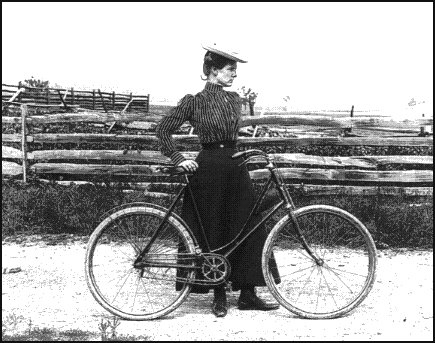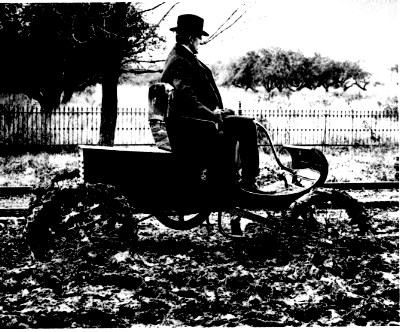
Bicycles,
Cars, and
High Art

In terms of dating the event, archæological evidence suggests the wheel came around about five thousand years ago, with the first ones used for ritualistic and ceremonial purposes --- carrying effigies of deities or important persons. Apparently closely linked in time and function, wheeled vehicles came into military use as chariots and battle wagons.But the next great advance, and it came several thousand years later, was the bicycle, invented in France as an amusement for rich and agile gentlemen. Subsequent technical refinements in the United States led to the "bicycle craze" as production boomed over the 1892-1897 period, with women joining in the sport. The bicycle's subsequent "serious" use as a basic mode of transportation (in some places) came only after mass automobile production was under way in the United States. But in the meantime, the bicycle brought on important technical innovations like the pneumatic tire, breakthroughs in ball bearings, seamless steel tubes (for the bicycle's frame) and the first use of stamped sheet metal (in 1890), thus replacing the more expensive foundry method for forming parts. The socially significant bicycle riding public created societies that lobbied governments to build better roads.
The car industry similarly was born for fun, as a plaything for the rich --- not as a rational device to move people and goods. The first car, created by Benz in 1886, was ridiculed by the head of the German patent office, who declared that the internal combustion engine, which then was thought appropriate only for stationary applications, "has as little future as steam for motivating road vehicles." Others referred to it as the result of Benz's "mad obsession," consumed as he was by speed at any practical cost. Chevrolet, who started one of the early companies that was to become merged into General Motors, was a racing enthusiast, as were other U.S. car builders. The races, well publicized and greeted with sensation wherever they were held, helped spark general interest in automobiles.
The look of the car became no less æstheticized. Roland Barthes not altogether approvingly recorded the "intense amorous studiousness" with which people at a 1950s Paris exhibition admired a new-model Citroen car: "the bodywork, the lines of union are touched, the upholstery palpated, the seats tried, the doors caressed, the cushions fondled." Cars, said Barthes, "are almost exactly the equivalent of the great Gothic cathedrals ... conceived with passion by unknown artists, and consumed in image if not in usage by a whole population which appropriates in them a wholly magical object."
The history of car production displays what goes wrong when makers think the car is merely a device for transit. Understanding the automobile as magical object was not in Henry Ford's repertoire. As Michael Schwarts and Frank Romo note, his production equipment gave no consideration to the possibility of periodic design changes. Hence "the boxy body of the Model T... was maintained long after the technology was available for a more streamlined design because the metal stamping machines that were installed in the Ford plants could not create curved panels." Ford's production tools could do only one thing, albeit one thing well; half of them had to be scrapped when he finally did make the move toward "styling." Because his machines were also so close together on the shop floor, as a matter of efficiency, there was too little physical space to reconfigure them. Before retooling in the latter 1920s for its first style-oriented car, the Model A, Ford laid off massive numbers of workers and lost $18 million, providing "the most expensive art lesson in history."

Henry Ford's philosophy of "any color you want as long as it's black," lowered his company's market share from 55 per cent in the early '20s to less than 15 percent in 1927s. General Motors' cars outsold Ford's, and at higher prices. So in addition to whatever organizational smarts GM had over the competition, the aesthetic was a distinct GM edge. The company brought in Harley Earl, who had earlier gained some fame customizing cars for LA movie stars. Beginning with the inaugural project for which he had full responsibility, the 1927 La Salle car, GM began its solid run of profitability. The world's first automobile styling department was GM's, and it was set up under Earl's direction.After first innovating with color, including two-tone styling, Earl moved GM into deeper changes in body shapes. To gain a more rakish line, Earl smoothed steel over a built-in luggage compartment (today's "trunk" or "boot") to replace what had begun as, in fact, a bolted-on trunk. This also became the place to put the spare tire, which could then come off the car's exterior. To mold steel into the shapes he needed, engineers created dye casts to follow the desired forms, including the "sporty" GM hardtop arrangement. GM developed simultaneously a special steel that was "flexible enough and strong enough to endure the tremendous strain" of the molding processes. The stream-line look, with a rolled steel body, enhanced the car's aerodynamic efficiency, decreased the number of its parts, lowered labor costs, increased security against theft, and quieted the ride. Analogous taste and engineering changes moved through appliances and other transportation equipment. One of the more famous was Raymond Loewy's first streamlined locomotives for Pennsylvania Railroad, eliminating rivets he thought made the train look "unfinished and clumsy." The new design saved millions in fabricating costs.
By the '50s, the U.S. car companies moved into what Edson Armi (one of the few art historians to take cars seriously) calls "more irregularly sculpted cars (that) have more in common with the automatism of postwar expressionist painters and their biomorphic fantasies. . . with, in the case of the flagship 1957 Cadillac, "Duchamp, Gropius and Marinetti all commingled in the tail fin." Despite the great appeal these products first had, things again changed --- in terms of popular taste as well as the engineering and sales performance of the U.S. vehicles. The Big Three lost out to foreign producers who eschewed Detroit's chrome bucket reruns. Designers often disagree on æsthetic issues, but nowhere have I found a designer praise U.S. autos of the late 1970s and 1980s. Fortune magazine, in a 1988 review of "five products U.S. companies design badly," listed cars, making an exception for the Ford Taurus. Cars from Germany, Italy, and most triumphantly Japan have been more highly regarded for their styling, fuel efficiency, and --- with the exception of Italy --- reliability. The combination of failings in the U.S. product devastated Midwest economies and eroded billions in corporate worth. All this, I would argue because, at least in significant degree, U.S. makers were unable to find the right art when they needed it.
--- From Where Stuff Comes From
Harvey Molotch
©2003Routledge